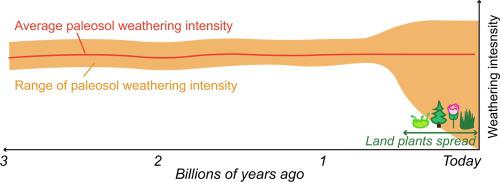Gondwana Research ( IF 7.2 ) Pub Date : 2022-05-18 , DOI: 10.1016/j.gr.2022.05.009 Rebecca M. Dzombak , Nathan D. Sheldon

|
Although continental weathering intensity has been invoked as a primary control on biogeochemistry, tectonics, and the carbon cycle throughout geologic history, it remains poorly quantified over Earth’s history. As a direct product of continental weathering, paleosols (fossil soils) offer unique insight into past weathering intensity, but they remain underused in efforts to constrain terrestrial weathering patterns over geologic time. Here, we compile the largest terrestrial weathering record to date, comprising 248 paleosol and weathering profiles that span three billion years. We analyze a suite of weathering indices to test common hypotheses around state-changes in terrestrial weathering intensity due to atmospheric changes and terrestrial biosphere expansion. Contrary to commonly invoked assumptions, we find that these weathering indices reflect consistent average terrestrial weathering intensity through time. No unidirectional state changes in average weathering intensity, as have previously been hypothesized, are detectable in the record. However, Phanerozoic paleosols preserve an increase in the total range of Chemical Index of Alteration (CIA) values, with the increased CIA range driven by the appearance of high-CaO paleosols. We compare the paleosol weathering record to weathering intensities recorded by select fluvial sandstones and diamictites.
We interpret the overall stability of the continental weathering record as reflecting the baseline level of weathering from which the Earth system deviates during periods of perturbation (i.e., major climate transitions, rapid tectonic activity). With consistent weathering intensity over geologic timescales, the record supports subaerially-emerged continental area as a critical control on total potential erosional flux and nutrient flux to the oceans. The paleosol community should work to build an even more complete database of paleosol geochemistry to allow more nuanced analyses of terrestrial weathering through time.
中文翻译:

风化的陆地记录表明 30 亿年的动态平衡
尽管大陆风化强度在整个地质历史中被认为是对生物地球化学、构造和碳循环的主要控制,但在地球历史上仍然很难量化。作为大陆风化的直接产物,古土壤(化石土壤)提供了对过去风化强度的独特见解,但它们在限制地质时间的陆地风化模式方面仍未得到充分利用。在这里,我们编制了迄今为止最大的陆地风化记录,包括跨越 30 亿年的 248 个古土壤和风化剖面。我们分析了一套风化指数,以检验由于大气变化和陆地生物圈扩张引起的陆地风化强度状态变化的常见假设。与通常引用的假设相反,我们发现这些风化指数反映了随时间变化的一致的平均陆地风化强度。如先前假设的那样,在记录中没有检测到平均风化强度的单向状态变化。然而,显生宙古土壤保持化学蚀变指数(CIA)值的总范围增加,CIA范围的增加是由高CaO古土壤的出现驱动的。我们将古土壤风化记录与选定河流砂岩和混杂岩记录的风化强度进行比较。显生宙古土壤保持化学蚀变指数 (CIA) 值的总范围增加,CIA 范围的增加是由高 CaO 古土壤的出现驱动的。我们将古土壤风化记录与选定河流砂岩和混杂岩记录的风化强度进行比较。显生宙古土壤保持化学蚀变指数 (CIA) 值的总范围增加,CIA 范围的增加是由高 CaO 古土壤的出现驱动的。我们将古土壤风化记录与选定河流砂岩和混杂岩记录的风化强度进行比较。
我们将大陆风化记录的整体稳定性解释为反映地球系统在扰动期间(即主要气候转变、快速构造活动)偏离的风化基线水平。在地质时间尺度上具有一致的风化强度,该记录支持地下出现的大陆区域作为对海洋总潜在侵蚀通量和养分通量的关键控制。古土壤社区应该努力建立一个更完整的古土壤地球化学数据库,以便对随着时间的推移进行更细致入微的陆地风化分析。











































 京公网安备 11010802027423号
京公网安备 11010802027423号